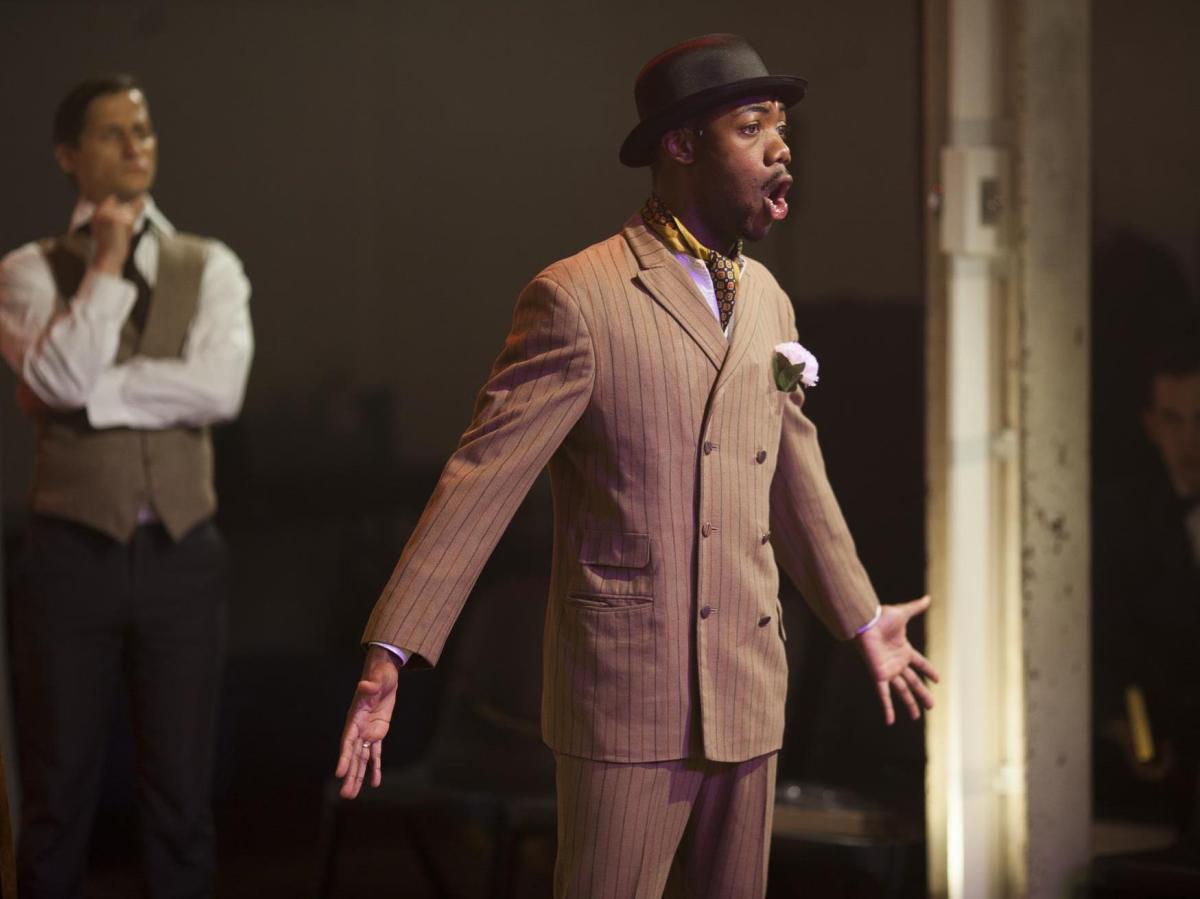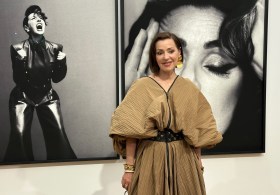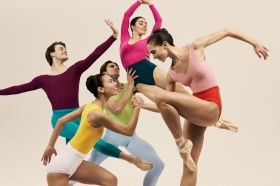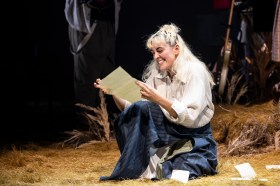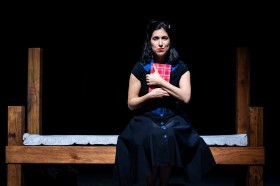Timothy Springs as Jim Conley. Image by Angus Scott.
Jason Robert Brown and Alfred Uhry’s Parade is pretty much as dark as music theatre gets. The plot details the real life case of the murder of thirteen-year-old Mary Phagan (Jemma Plunkett) and the criminal trial and subsequent conviction of prime suspect Leo Frank (Luigi Lucente) in Marietta, Georgia in 1913. Frank was a Brooklyn native of Jewish descent who married Southern woman Lucille Selig (Laura Fitzpatrick) and he was Mary’s boss at the pencil factory where she was employed. The events caused a national sensation while highlighting the corrupt nature of the judicial system and the anti-Semitic underbelly of the community. A lynch mob hanged Frank after his sentence was reduced to life in prison following a lengthy appeal process.
While this might not sound as the typical basis for a musical, the authors juxtapose the grim nature of the events with the burgeoning passionate relationship between Leo and Lucille. We witness their marriage develop from a somewhat cold union to unconditional love and respect. Through a seamless integration of music and drama Parade is undeniably provocative and highly emotional; Uhry’s book is challenging and fast-paced while Brown’s thrilling score is at once incredibly intricate and sweepingly romantic. While not an initial success in its late 90s Broadway debut, Parade has developed a reverence amongst music theatre devotees and was retooled for its London premiere in 2007. This production is based on that incarnation of the show.
The Collective have set themselves an enormous challenge in selecting Parade as their debut production. But this bravery has more than paid off; this show is simply spectacular. The creative team uses the versatile performance space at fortyfivedownstairs brilliantly. The audience is split in half facing each other as the central action predominantly plays out in the middle runway created by the seating arrangement. The stage is flanked by a giant moss covered tree at one end and a raised wooden platform at the other. The entire space is decorated with patriotic red, white and blue flags and simple items such as chairs, desks and wooden crates are incorporated into the staging as needed. Set Designer and Scenic Artist Alexandra Hiller has created an unobtrusive and effective stage design that succeeds in keeping the audience focussed on the realities of the events taking place. Similarly, Nerissa Saville’s costumes reflect the period with a splash of lushness here and there but always with an overriding sense of verisimilitude.
The superb cast of Parade is lead by Luigi Lucente and Laura Fitzpatrick as Leo and Lucille Frank. A seasoned performer in the local music theatre scene, Fitzpatrick may have found her most successful role to date with Lucille. She is warm, confused, frustrated and fiery; perfectly capturing the combination of tempestuousness and stoicism required for the role. Fitzpatrick is also blessed with a gorgeous voice that does Brown’s celebrated score justice; a major highlight being her rendition of ‘You Don’t Know This Man’ in act one.
Lucente’s portrayal of Leo is hard to put into words, but I’ll try. He is all stuttering idiosyncratic nervousness coupled with such unabashed conviction and strength that it is an overwhelming performance. Lucente also brings such a grounded sense of realism to the role that you almost forget this is practically a through-sung musical; you are simply swept up in it. He totally immerses himself in the challenging role and tackles the musical requirements of the material with amazing assuredness and flair.
The hard-working ensemble cast are fantastic, playing multiple roles, constantly facilitating set and costume changes and successfully creating a sense of scale to the dramatic narrative. They also navigate the difficult harmonies and rhythms of the score with ease. Some standout performances include Cameron Maconald in fine voice as opportunistic reporter Britt Craig, Amelia Christo in dual roles as the devastated Mrs. Phagan/dry Southern dame Sally Slaton and Andrew Doyle’s cheeky Frankie Epps.
Under the steady hand of James Cutler’s direction Parade moves at a swift pace and brilliantly involves the audience in the tumultuous events taking place. Once the trial begins and various cast members join the audience the immersive nature of the staging is thrilling. Cutler successfully focuses attention within the unconventional stage design, aided by Jason Bovaid’s lighting, and assures that the performers play to both sides of the audience at all times. Add David Harford’s inventive choreography to the mix and the whole show flows like one extended production number.
There are many wonderful moments of ingenious staging, but one standout is the number ‘Come Up To My Office’ in which the factory girls describe Leo’s lecherous nature to the courtroom. In this frenzied fantasy sequence Lucente energetically weaves between the girls and dances with them while the emotion written on their faces suggests that they are not enjoying it one bit. This is just one example in a production where direction, staging and choreography come together to create something truly magnificent.
The Collective’s Parade is one of those rare occasions where creative team, cast and performance space combine in perfect symbiosis to present a fantastic piece of theatre in a thrillingly brilliant and highly emotional way. Go and see it before the parade passes by!
Rating: 4 ½ out of 5 starsParade
Presented by The Collective
fortfivedownstairs, Flinders Lane
www.fortyfivedownstairs.com
17 – 28 September
